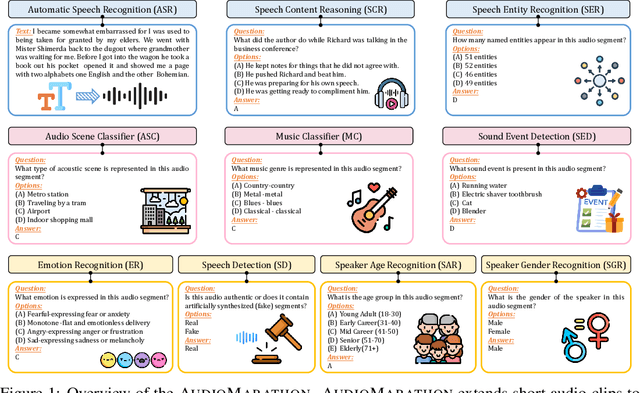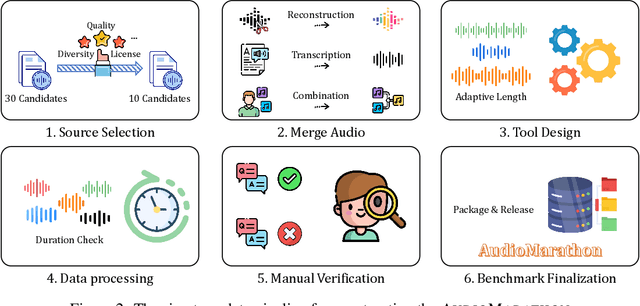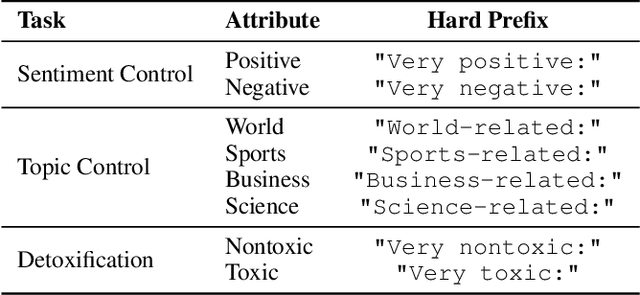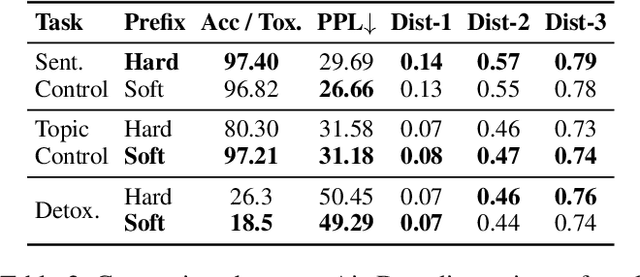Jiabing Yang
AudioMarathon: A Comprehensive Benchmark for Long-Context Audio Understanding and Efficiency in Audio LLMs
Oct 08, 2025



Abstract:Processing long-form audio is a major challenge for Large Audio Language models (LALMs). These models struggle with the quadratic cost of attention ($O(N^2)$) and with modeling long-range temporal dependencies. Existing audio benchmarks are built mostly from short clips and do not evaluate models in realistic long context settings. To address this gap, we introduce AudioMarathon, a benchmark designed to evaluate both understanding and inference efficiency on long-form audio. AudioMarathon provides a diverse set of tasks built upon three pillars: long-context audio inputs with durations ranging from 90.0 to 300.0 seconds, which correspond to encoded sequences of 2,250 to 7,500 audio tokens, respectively, full domain coverage across speech, sound, and music, and complex reasoning that requires multi-hop inference. We evaluate state-of-the-art LALMs and observe clear performance drops as audio length grows. We also study acceleration techniques and analyze the trade-offs of token pruning and KV cache eviction. The results show large gaps across current LALMs and highlight the need for better temporal reasoning and memory-efficient architectures. We believe AudioMarathon will drive the audio and multimodal research community to develop more advanced audio understanding models capable of solving complex audio tasks.
EgoDemoGen: Novel Egocentric Demonstration Generation Enables Viewpoint-Robust Manipulation
Sep 26, 2025Abstract:Imitation learning based policies perform well in robotic manipulation, but they often degrade under *egocentric viewpoint shifts* when trained from a single egocentric viewpoint. To address this issue, we present **EgoDemoGen**, a framework that generates *paired* novel egocentric demonstrations by retargeting actions in the novel egocentric frame and synthesizing the corresponding egocentric observation videos with proposed generative video repair model **EgoViewTransfer**, which is conditioned by a novel-viewpoint reprojected scene video and a robot-only video rendered from the retargeted joint actions. EgoViewTransfer is finetuned from a pretrained video generation model using self-supervised double reprojection strategy. We evaluate EgoDemoGen on both simulation (RoboTwin2.0) and real-world robot. After training with a mixture of EgoDemoGen-generated novel egocentric demonstrations and original standard egocentric demonstrations, policy success rate improves **absolutely** by **+17.0%** for standard egocentric viewpoint and by **+17.7%** for novel egocentric viewpoints in simulation. On real-world robot, the **absolute** improvements are **+18.3%** and **+25.8%**. Moreover, performance continues to improve as the proportion of EgoDemoGen-generated demonstrations increases, with diminishing returns. These results demonstrate that EgoDemoGen provides a practical route to egocentric viewpoint-robust robotic manipulation.
DTPA: Dynamic Token-level Prefix Augmentation for Controllable Text Generation
Aug 06, 2025



Abstract:Controllable Text Generation (CTG) is a vital subfield in Natural Language Processing (NLP), aiming to generate text that aligns with desired attributes. However, previous studies commonly focus on the quality of controllable text generation for short sequences, while the generation of long-form text remains largely underexplored. In this paper, we observe that the controllability of texts generated by the powerful prefix-based method Air-Decoding tends to decline with increasing sequence length, which we hypothesize primarily arises from the observed decay in attention to the prefixes. Meanwhile, different types of prefixes including soft and hard prefixes are also key factors influencing performance. Building on these insights, we propose a lightweight and effective framework called Dynamic Token-level Prefix Augmentation (DTPA) based on Air-Decoding for controllable text generation. Specifically, it first selects the optimal prefix type for a given task. Then we dynamically amplify the attention to the prefix for the attribute distribution to enhance controllability, with a scaling factor growing exponentially as the sequence length increases. Moreover, based on the task, we optionally apply a similar augmentation to the original prompt for the raw distribution to balance text quality. After attribute distribution reconstruction, the generated text satisfies the attribute constraints well. Experiments on multiple CTG tasks demonstrate that DTPA generally outperforms other methods in attribute control while maintaining competitive fluency, diversity, and topic relevance. Further analysis highlights DTPA's superior effectiveness in long text generation.
EC-Flow: Enabling Versatile Robotic Manipulation from Action-Unlabeled Videos via Embodiment-Centric Flow
Jul 08, 2025



Abstract:Current language-guided robotic manipulation systems often require low-level action-labeled datasets for imitation learning. While object-centric flow prediction methods mitigate this issue, they remain limited to scenarios involving rigid objects with clear displacement and minimal occlusion. In this work, we present Embodiment-Centric Flow (EC-Flow), a framework that directly learns manipulation from action-unlabeled videos by predicting embodiment-centric flow. Our key insight is that incorporating the embodiment's inherent kinematics significantly enhances generalization to versatile manipulation scenarios, including deformable object handling, occlusions, and non-object-displacement tasks. To connect the EC-Flow with language instructions and object interactions, we further introduce a goal-alignment module by jointly optimizing movement consistency and goal-image prediction. Moreover, translating EC-Flow to executable robot actions only requires a standard robot URDF (Unified Robot Description Format) file to specify kinematic constraints across joints, which makes it easy to use in practice. We validate EC-Flow on both simulation (Meta-World) and real-world tasks, demonstrating its state-of-the-art performance in occluded object handling (62% improvement), deformable object manipulation (45% improvement), and non-object-displacement tasks (80% improvement) than prior state-of-the-art object-centric flow methods. For more information, see our project website at https://ec-flow1.github.io .
 Add to Chrome
Add to Chrome Add to Firefox
Add to Firefox Add to Edge
Add to Edge